The Toshiba 40RV753 is the successor to the company’s Regza RV635 series of LCD TV back in 2009. Sadly, due to the economic turmoil and recent high net losses, Toshiba has withdrawn its traditional premium quality HDTV range from the western market, following in the footsteps of Sharp, JVC and Hitachi to concentrate their efforts in Japan and other Asian countries. The Japanese TV maker also transferred manufacturing from Plymouth to Poland in an effort to cut labour costs.
<!-- google_ad_client = 'pub-2887677957235196'; google_ad_slot = '4990177225'; google_ad_width = 336; google_ad_height = 280; //-->
With these points in mind, we were not really expecting the Toshiba 40RV753 to surpass its South Korean competitors, but thankfully our reservations failed to materialise. In fact, the 40RV753B could be one of the best 40-inch LCD displays on the market. So without further ado, let’s move on to the review.
Note: The specific model we tested was the Toshiba 40RV753B, which denotes the 3-pin-plug British version, even though the same LCD television may be marketed by major retailers/ etailers as Toshiba 40RV753, 40RV753B, 40RV753D or 40RV753DB. Because the LCD TV is in direct competition with the Samsung LE40C580 in terms of features, performance and price, they will be compared against each other from time to time in this article.
Thankfully the design and build quality of the Toshiba 40RV753 have not been sacrificed in comparison to the RV635 range. The ultra-tough plastic shell and piano-black finish are all too familiar. Despite cost-cutting, the company still managed to preserve the illuminated Toshiba Logo at the front, which complements the overall design and elevates its status. In fact, one could mistake the 40RV753B to be of higher value (akin to the previous models).

In addition, just like its predecessor, the Toshiba 40RV753 features a hard power switch for complete shutdown during prolonged absence.
The location of the AV ports and the build quality are in keeping with today’s standards. The PSU is located in the middle, and the mainboard (which contains the processing elements) is located on the right. It might have been better to place the PSU on the left to prevent interference and heat build-up, as the mainboard is quite large and has less room to breathe compared to the Samsung LE40C580.
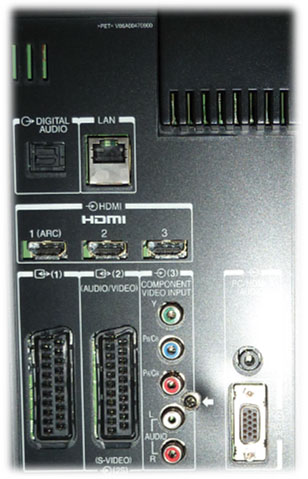
It is also worth noting that the power cord is attached to the LCD TV, which could pose a problem to some users.
The Toshiba 40RV753’s GUI is identical to the 32RV635 we reviewed in August 2009, with all the features intact. The GUI’s performance is also similar, which is not bad to say the least, but its responsiveness could probably be improved to enhance user experience.
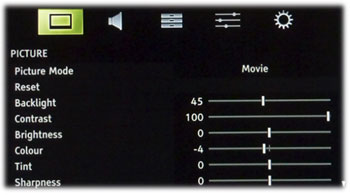
The user menu is filled with both basic and advanced options, which may confuse some users, but it is better to offer such picture-affecting controls than not. Unfortunately, the 3D CMS (colour management system) remains broken: some relabelling is required since [Saturation] controls the luminance, and [Luminance] seems to control the gamma. Thankfully gamma and greyscale controls are well implemented.
The 40RV753B also features independent source and resolution settings, allowing users to customise the image according to the source and resolution.
Note: [Picture Mode], [Aspect Ratio], [Sleep Timer] and [Media Player] can be accessed via the [Quick Menu].

The supplied remote is essentially the mid-range 2007 model that has been reintroduced into circulation, which is certainly better than the low-end remote that is often bundled with budget Toshiba sets. Responsiveness could be improved, but overall the performance is comparable to others we have tested thus far.
Greyscale and Gamma accuracy is vital for portraying any given image correctly. Therefore, the display must be calibrated to a set of standards used by the industry. In the case of HDTV, the set standard for colour space is Rec. 709, (which is similar to sRGB). Both standards share the identical white point (D65), and we chose the gamma value of 2.2.
Greyscale calibration ensures all greys between black and white are free from colour dominance, which is achieved by assigning the RGB values to 6500K Correlated Colour Temperature (CCT). Regrettably, it is not possible for a television display to yield 100% accuracy, so the goal is to maintain errors within acceptable levels (as indicated by Delta E values).
Unfortunately we were unable to obtain flat 6500K CCT and 2.2 Gamma via any of the default presets. However, setting Colour Temperature to 2 and Static Gamma to -5 did yield acceptable level of quality. Akin to previous Toshiba models, the 3D CMS is flawed, but thankfully it can be used to set the correct luminance levels of primary and secondary colours.
Note: The results below were obtained by placing the colorimeter at the centre of the LCD screen to ensure error values are kept to a safe minimum.
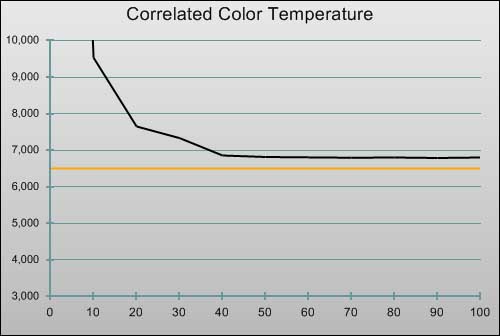 |
| Pre-calibration CCT in [Movie] mode |
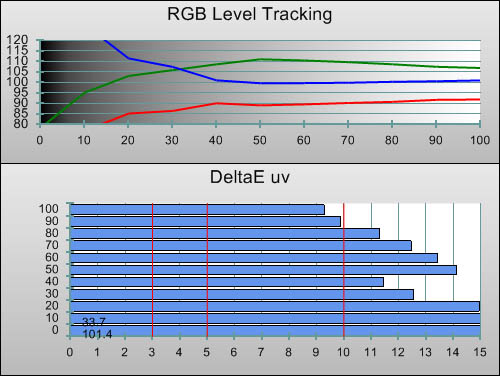 |
| Pre-calibration RGB tracking and delta errors (dEs) |
![Post-calibration CCT in [Movie] mode](https://www.hdtvtest.co.uk/news/wp-content/uploads/2018/04/hdtv_Toshiba-40RV753_post-cct.jpg) |
| Post-calibration CCT in [Movie] mode |
![Post-calibration RGB Tracking in [Movie] mode](https://www.hdtvtest.co.uk/news/wp-content/uploads/2018/04/hdtv_Toshiba-40RV753_post-rgb.jpg) |
| Post-calibration RGB tracking and dEs in [Movie] mode |
![Gamma curve in [Movie] mode](https://www.hdtvtest.co.uk/news/wp-content/uploads/2018/04/hdtv_Toshiba-40RV753_post-gamma.jpg) | |
| Gamma curve in [Cinema] mode | Corresponding gamma tracking |
![Post-calibration CIE chart in [Movie] mode](https://www.hdtvtest.co.uk/news/wp-content/uploads/2018/04/hdtv_Toshiba-40RV753_post-cie.jpg) |
| Post-calibration CIE chart with reference to HD Rec.709 |
![Post-calibration Luminance levels in [Movie] mode](https://www.hdtvtest.co.uk/news/wp-content/uploads/2018/04/hdtv_Toshiba-40RV753_post-colour-lum.gif) |
| Post-calibration colour luminance (coloured bars = targets; black bars = measured values) |
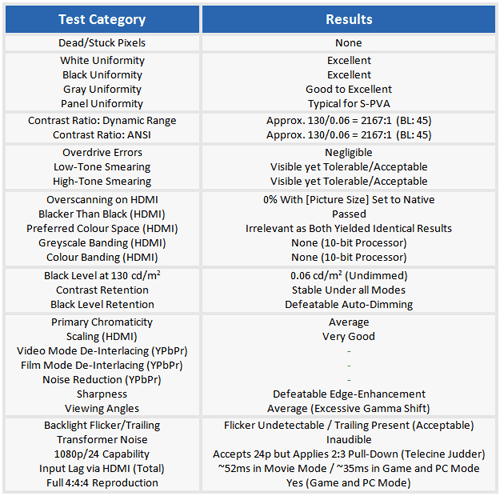
The Samsung LTA400HM02 LCD panel embedded within the Toshiba 40RV753 produced excellent overall uniformity, which is quite remarkable for SPVA panel. During the pure white test (100IRE), the classic red and green tinting commonly found on LCDs was absent. Backlight bleeding was well controlled (non-existent to the human eye), and the panel uniformity was typical for a consumer-grade display. There were few visible defects and imperfections across the panel (e.g. transparent vertical bars), which hinder calibration accuracy somewhat. However, such errors are common to most consumer-grade LCD TVs, and are extremely difficult to avoid.
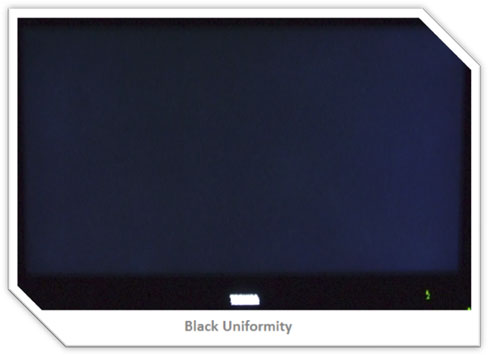
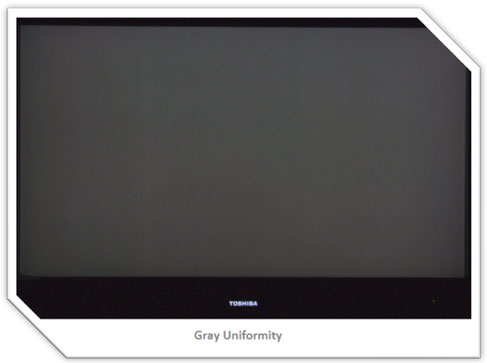
The Toshiba 40RV753B in [Movie Mode] with white level (contrast) set to 100 yielded a dynamic range of 2167:1 (BL: 45) and ANSI of ~2167:1 (BL: 45), which is rather average for a 2010 SPVA panel since the LTF400HM01 embedded within the Samsung 40C580 managed to surpass 4000:1 without the help of backlight dimming. Then again, we haven’t seen any S-PVA out side of Samsung yielding such deep blacks.
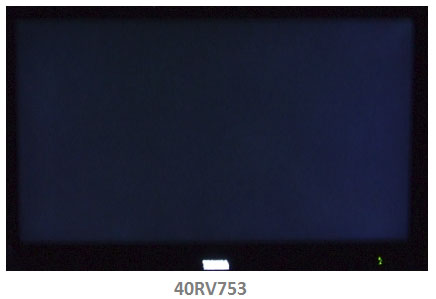
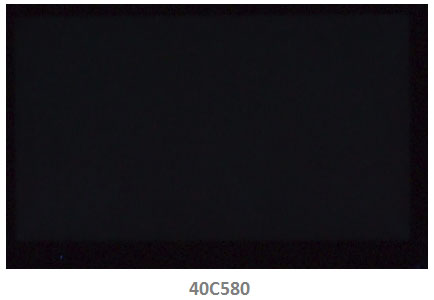
Upon testing via PixPerAn, it was immediately apparent that the motion signature of the LTA400HM01 is identical to LTF400HM01. Thankfully, unlike the LTF400HM01, the LTA400HM02 does not suffer from inverse ghosting, which means the Toshiba 40RV753 is an excellent option for those who cannot tolerate this artefact.
Motion blur inherent to LCDs is widely regarded as a negative attribute. In truth, the detrimental effect is exclusive to High-Motion Contents (48, 50 and 60i/p) as it obscures fine details during motion. Low-Motion contents (24, 25 and 30p) however benefit from the inherent blur, as it helps to reduce frame judder caused by prolonged latency between individual frames thus creating the illusion of continuous free-flowing motion, which appears easier on the eye. Some refer to it as soft motion as opposed to hard motion where continuous images appear as series of stills due to the lack of blur. Since the majority of today’s contents are based on Low-Motion (which includes the majority of Sony PS3 and Microsoft Xbox 360 titles), a standard 60Hz LCD is more than sufficient. However, fans of fast-paced contents and 60p games should avoid LCD and invest in a plasma TV instead.
Overscanning: The aspect ratio can be configured via the Quick Menu, which offers wide range modes to choose from.
Blacker than Black (HDMI): The Toshiba 40RV753B accepts both 0-255 and 16-235 formats via HDMI (RGB).
![]()
Viewing Angle: The viewing angle of the LTA400HM02 LCD module is identical to the LTF400HM01 found on the 40C580, which is quite average and suffers from excessive gamma shift. On bright contents, visible evidence of off-angle gamma shifts and desaturated colours are kept to a bare minimum. However, on dark contents, off-angle gamma shifts highlighted portions of the image that should remain invisible to the viewer. It also highlighted noise and dithering artefacts caused by heavy compression, which could pose a problem if the owner’s friends are highly critical concerning image quality. Thankfully, viewing the unit dead-on from the recommended distance of two meters did amend the imperfections. If one requires a HDTV display with wide viewing angles, it is best to opt for a plasma television or an IPS LCD (preferably locally-dimmed for deeper blacks).
Sharpness: The Toshiba Regza 40RV753 fully supports full 1:1 pixel mapping.
To evaluate the picture quality rendered by the LCD TV, a couple of carefully chosen images are used to detect visible artefacts/errors. Image Aeon is used to detect errors in skin-tone, luminance and depth, while Acela Express is used to detect greyscale and gamma error in addition to black crush.
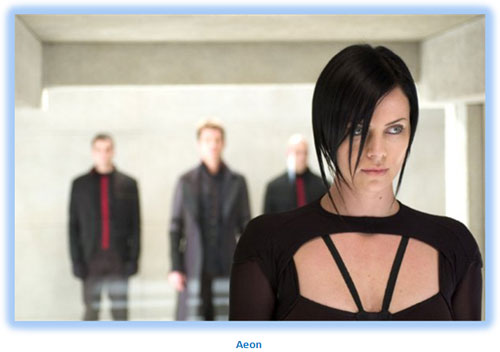
The Toshiba RV753 yielded good results following basic calibration in Movie Mode. The preset greyscale was slightly shifted towards green, which can only be rectified via colorimeter.
Once calibrated to Rec. 709 and 6500k, the mass shades of warm colours that envelop Charlize Theron’s face, neck and chest were clearly visible (close to a calibrated display). A sense of depth was also present.

As predicted, the performance of the Toshiba 40RV753B was excellent and comparable to the calibrated Dell 2209WA once calibrated. There was no evidence of any serious black crush or any form of gamma error.
As expected, both high-definition and standard-def materials were beautifully rendered via HDMI on the Toshiba 40RV753, thanks to the HDTV’s outstanding 10-bit processor. I failed to spot any form of error that would normally destroy or severely impact the picture quality (even though the colour chromaticity wasn’t perfect). The three secondary colors and the primary green color failed to conform to the Rec. 709 standard, but thankfully, we couldn’t spot any errors without a reference display and even then, we only noticed minor difference when paused or displaying still images. The most notable difference was the skin tone, which appeared to be slightly recessed, but it did help create natural and convincing look (unlike the C580, which had heightened magenta that can only be reduce to tolerable levels by adjusting the tint and flash tone).
Even though the 3D CMS was flawed, it did help us obtain the correct colour luminance for all primary and secondary colours. However, it is worth noting that it will only benefit those who own a colorimeter and possess the necessary skills. The 40RV753 also fully supports 4:4:4 and 10-bit in Game and PC mode, which is ideal for those who wish to use the display as a monitor.
It is a shame that the Regza 40RV753 is fitted with an LCD panel with slightly inferior black level that failed to match the black-level performance of the S-LCD 40C580 with its plasma-beating blacks (excluding 2nd-Gen NeoPDP screens). However, the black level was still sufficient to render dark scenes with a certain degree of depth.
On the negative side, the Toshiba 40RV753B lacks true 24p support. During testing, the LCD television accepted 1080p/24 video signal, but it was converted to 60p via 2:3 (Telecine Pull-Down). We do not believe this to be an error, as previous standard LCDs from Toshiba did not feature true 24p support.
The input lag of the 40RV75B is similar to that measured on the Samsung 40C580 (both yielding around 35ms in Game Mode), so the Toshiba LCD HDTV is ideal for console games. However, gamers who often play 60p games may want to invest in a Panasonic NeoPDP plasma for smear/blur-free motion with ultra-low input lag, but make sure to factor in phosphor trailing as this phenomenon may annoy users who are sensitive to uneven phosphor decay.
Previous Toshiba TV sets were praised for their acoustic performance, but unfortunately the sound quality of the Toshiba 40RV753 is only comparable to last year’s Samsung flat-screen LCD models. Simply put, it is merely suitable for dialogue, which is rather bizarre considering the 40RV753 is fitted with the same-size speakers as the 40C580. Fortunately the audio can be outsourced to a pair of Active Speakers or a surround sound system.
The cheapest solution is to purchase the Creative T20 Series II and connect it via the 3.5mm Headphone Jack on the TV. It will allow the user to directly control the sound via the LCD television’s remote.
Initially we were not expecting the Toshiba 40RV753 to perform well in any category, but boy are we glad to discover that our expectations were misplaced, because the LCD TV is really an excellent alternative to the Samsung LE40C580. In fact, the Toshiba is superior to the Samsung in all aspects except for the black level and the on-board audio.
Between the 40RV753B and the LE40C580, opt for the former (Toshiba) if you don’t fancy your chance of obtaining an A-MVA panel with the Samsung C580, or if you place greater value on image accuracy over deeper blacks. On the other hand, if you are after more stylish aesthetics, plasma-beating blacks and integrated media capabilities at the cost of minor colour inaccuracy, then opt for the Samsung.

<!-- google_ad_client = 'pub-2887677957235196'; google_ad_slot = '0693194791'; google_ad_width = 336; google_ad_height = 280; //-->